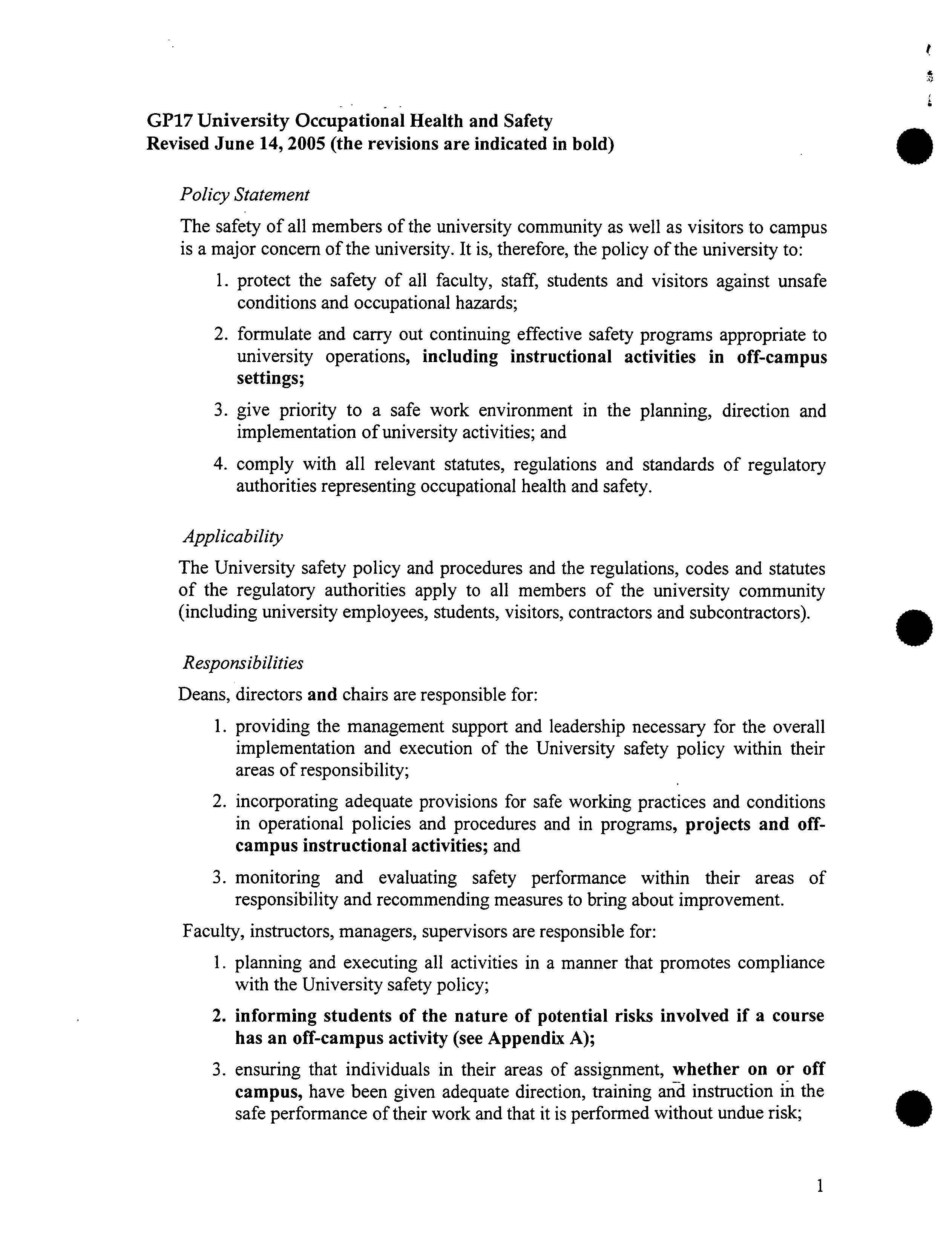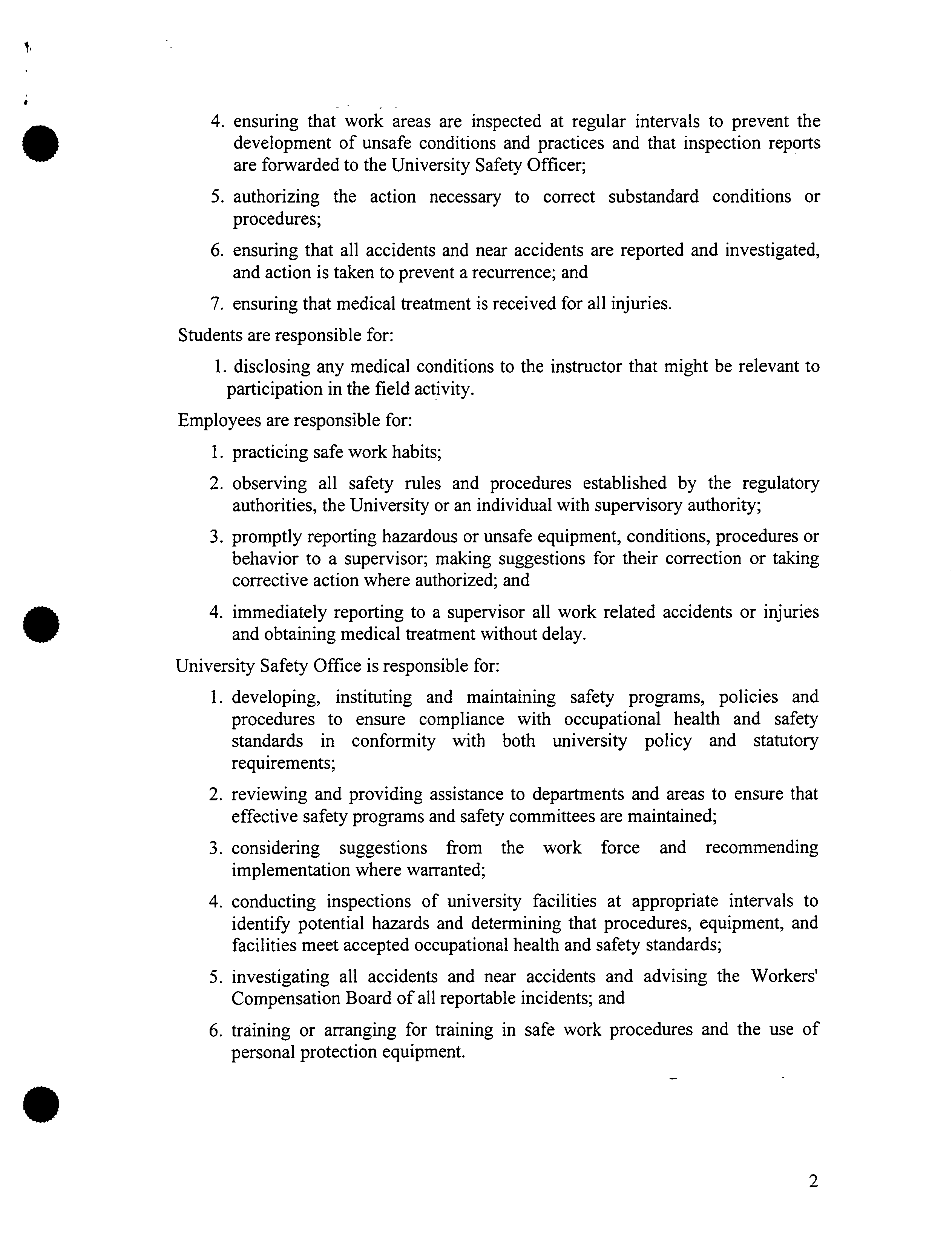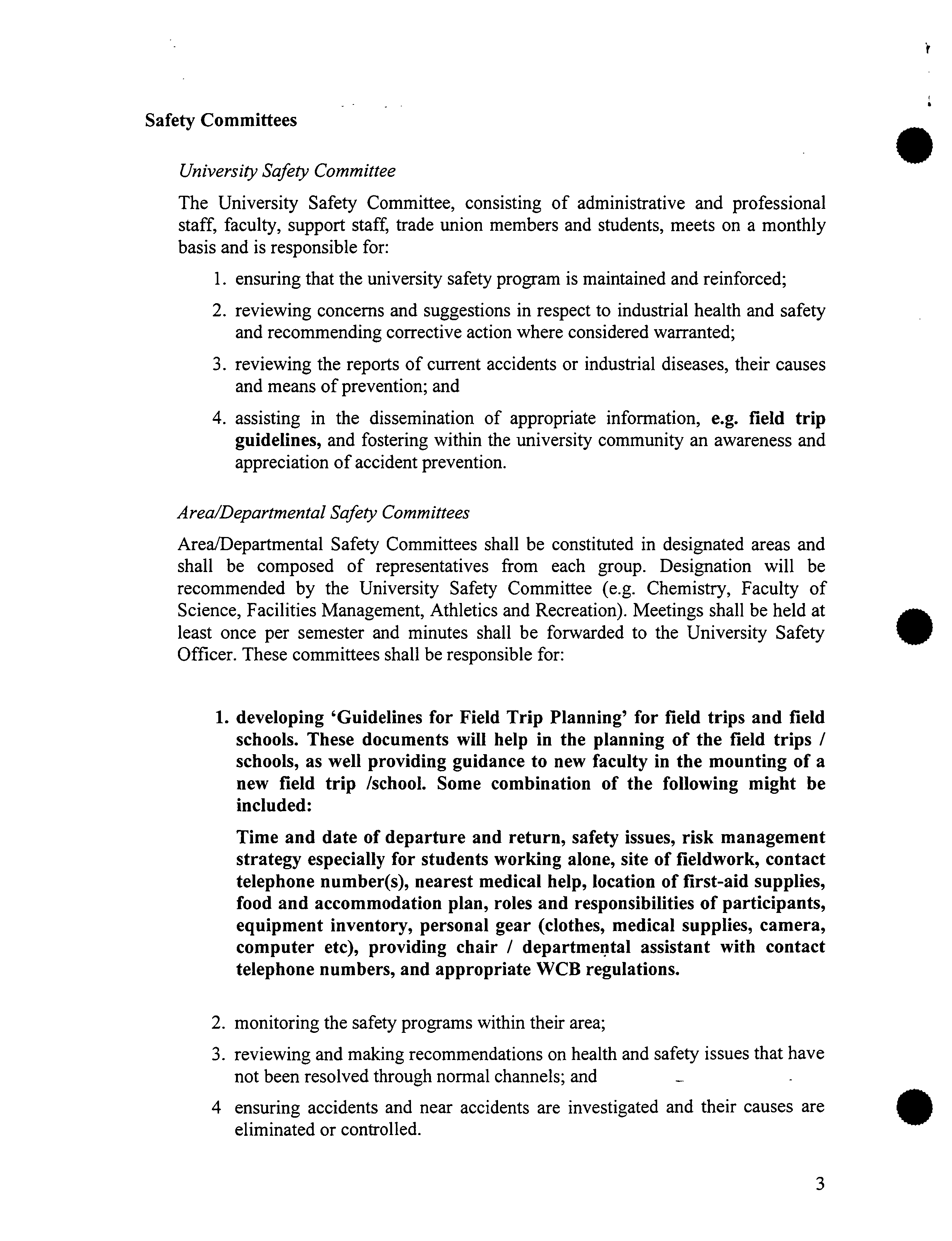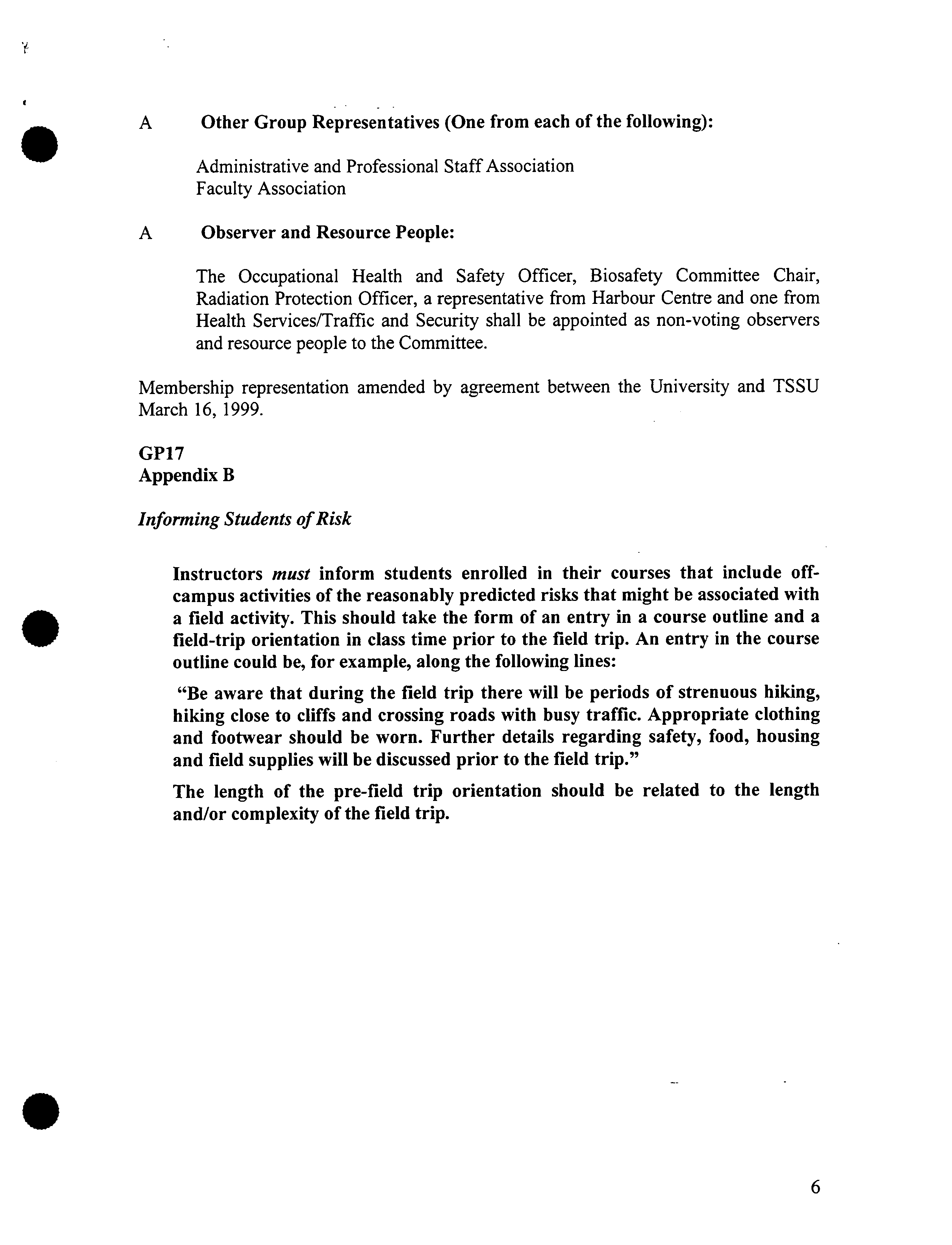For Information
?
S.05-91
• ?
SIMON FRASER UNIVERSITY
MEMORANDUM
OFFICE OF VICE-PRESIDENT, RESEARCH
TO:
Senate ?
FROM: B. Mario Pinto
Vice President, Research
RE: Review of Policy GP17 University
?
DATE: June 14, 2005
Occupational Health and Safety
In December 2004, as Vice-President, Research, I formed a Task Force, consisting of eight
members, with Mike Roberts as Chair, to examine the necessity for a policy concerning off-
campus activities. The mandate was to investigate the situation with respect to personal
safety and risk management for University activities, limited to research and teaching, that
are carried out in places other than SFU.
The Task Force submitted their report in March, 2005 and after revisions, this report was
posted on the Vice-President, Research's website for comment by the university community.
• ?
Responses were accepted until May 15, 2005, and the draft policy was modified accordingly.
The Task Force concluded that GP 17 of the University's Policies and Procedures already
established the principles and policy framework for risk management practices regarding off-
campus research and teaching. However, it did make certain recommendations for revision
of Policy GP 17. The revised policy is now being submitted to SCAR for discussion, to Senate
for information, and then to the Board of Governors for approval.
The Task Force also recommended that the following calendar entry pertaining to field
activities be listed in the calendar.
Calendar Entry for Field Activities
"Students who are involved in off-campus field trips, field schools, practica, exchanges
and internships, are advised that they may be exposed to risks associated with these
activities. Students are expected to act consistently with the behavioural expectations,
safety guidelines, and risk mitigation advice provided by their instructors or program
directors. Students are responsible for disclosing any medical conditions to the instructor
that might be relevant to participation in the field activity."
This recommendation is also being submitted to SCAR for discussion, to Senate for
information, and then to the Board of Governors for approval.
?
-
•
GP17
University Occupational Health and Safety
Revised June 14, 2005 (the revisions are indicated in bold)
Policy Statement
The safety of all members of the university community as well as visitors to campus
is a major concern of the university. It is, therefore, the policy of the university to:
1.
protect the safety of all faculty, staff, students and visitors against unsafe
conditions and occupational hazards;
2.
formulate and carry out continuing effective safety programs appropriate to
university operations,
including instructional activities in off-campus
settings;
3.
give priority to a safe work environment in the planning, direction and
implementation of university activities; and
4.
comply with all relevant statutes, regulations and standards of regulatory
authorities representing occupational health and safety.
Applicability
The University safety policy and procedures and the regulations, codes and statutes
of the regulatory authorities apply to all members of the university community
(including university employees, students, visitors, contractors and subcontractors).
Responsibilities
Deans, directors
and
chairs are responsible for:
1.
providing the management support and leadership necessary for the overall
implementation and execution of the University safety policy within their
areas of responsibility;
2.
incorporating adequate provisions for safe working practices and conditions
in operational policies and procedures and in programs,
projects and off-
campus instructional activities;
and
3.
monitoring and evaluating safety performance within their areas of
responsibility and recommending measures to bring about improvement.
Faculty, instructors, managers, supervisors are responsible for:
1.
planning and executing all activities in a manner that promotes compliance
with the University safety policy;
2. informing students of the nature of potential risks involved if a course
has an off-campus activity (see Appendix
A);
3.
ensuring that individuals in their areas of assignment,
whether on or off
campus,
have been given adequate direction, training aria instruction in the
safe performance of their work and that it is performed without undue risk;
.
1
4.
ensuring that work areas are inspected at regular intervals to prevent the
development of unsafe conditions and practices and that inspection reports
are forwarded to the University Safety Officer;
5.
authorizing ?
the ?
action necessary to ?
correct substandard ?
conditions or
procedures;
6.
ensuring that all accidents and near accidents are reported and investigated,
and action is taken to prevent a recurrence; and
7. ensuring that medical treatment is received for all injuries.
Students are responsible for:
1.
disclosing any medical conditions to the instructor that might be relevant to
participation in the field activity.
Employees are responsible for:
1. practicing safe work habits;
2.
observing all safety rules and procedures established by the regulatory
authorities, the University or an individual with supervisory authority;
3.
promptly reporting hazardous or unsafe equipment, conditions, procedures or
behavior to a supervisor; making suggestions for their correction or taking
corrective action where authorized; and
.
? 4.
immediately reporting to a supervisor all work related accidents or injuries
and obtaining medical treatment without delay.
University Safety Office is responsible for:
1.
developing, ?
instituting ?
and ?
maintaining ?
safety ?
programs, ?
policies ?
and
procedures to ensure compliance with occupational health and safety
standards ?
in ?
conformity ?
with ?
both ?
university ?
policy ?
and ?
statutory
requirements;
2.
reviewing and providing assistance to departments and areas to ensure that
effective safety programs and safety committees are maintained;
3.
considering ?
suggestions ?
from ?
the ?
work ?
force ?
and
?
recommending
implementation where warranted;
4.
conducting inspections of university facilities at appropriate intervals to
identify potential hazards and determining that procedures, equipment, and
facilities meet accepted occupational health and safety standards;
5.
investigating all accidents and near accidents and advising the Workers'
Compensation Board of all reportable incidents; and
6.
training or arranging for training in safe work procedures and the use of
personal protection equipment.
2
r
Safety
University
Committees
Safety Committee
S
The University Safety Committee, consisting of administrative and professional
staff, faculty, support staff, trade union members and students, meets on a monthly
basis and is responsible for:
1. ensuring that the university safety program is maintained and reinforced;
2. reviewing concerns and suggestions in respect to industrial health and safety
and recommending corrective action where considered warranted;
3.
reviewing the reports of current accidents or industrial diseases, their causes
and means of prevention; and
4. assisting in the dissemination of appropriate information,
e.g. field trip
guidelines,
and fostering within the university community an awareness and
appreciation of accident prevention.
Area/Departmental Safety Committees
Area/Departmental Safety Committees shall be constituted in designated areas and
shall be composed of representatives from each group. Designation will be
recommended by the University Safety Committee (e.g. Chemistry, Faculty of
Science, Facilities Management, Athletics and Recreation). Meetings shall be held at
least once per semester and minutes shall be forwarded to the University Safety
Officer. These committees shall be responsible for:
1. developing 'Guidelines for Field Trip Planning' for field trips and field
schools. These documents will help in the planning of the field trips /
schools, as well providing guidance to new faculty in the mounting of a
new field trip /school. Some combination of the following might be
included:
Time and date of departure and return, safety issues, risk management
strategy especially for students working alone, site of fieldwork, contact
telephone number(s), nearest medical help, location of first-aid supplies,
food and accommodation plan, roles and responsibilities of participants,
equipment inventory, personal gear (clothes, medical supplies, camera,
computer etc), providing chair / departmental assistant with contact
telephone numbers, and appropriate WCB regulations.
2.
monitoring the safety programs within their area;
3.
reviewing and making recommendations on health and safety issues that have
not been resolved through normal channels; and ? -
4 ensuring
eliminated
accidents
or controlled.
and near accidents are investigated and their causes are
?
5
3
L]
Special Safety Committees
•
These committees shall be composed of representatives of groups requiring special
safety consideration (e.g. radiation and radioisotope safety, biological hazards).
Meetings shall be held at least once per semester and minutes shall be forwarded to
the University Safety Committee. These committees shall be responsible for:
1.
monitoring the safety programs within their area of responsibility; and
2.
conducting inspections at regular intervals and recommending corrective
action to eliminate substandard conditions or procedures
GP 17
Attachment I
University Safety Committee
Terms of Reference
Committee Membership
This committee shall consist of 15 members who are experienced in the types of work at
the University. In compliance with WCB regulations, committee members are designated
. as representing the management of the University or representing worker groups
employed by the University as designated by the WCB (including student workers).
Efforts should be made to ensure all major work groups or areas are represented on the
committee (as shown in Appendix A, which can be amended from time to time by the
Vice-President, Finance and Administration). Management representatives can not
outnumber worker group representatives on the committee. Management representatives
are appointed by the Vice- President, Finance and Administration. Worker group and
other representatives shall be elected or appointed by their peers. The Vice-President,
Finance and Administration may appoint non-voting observers and resource people to the
Committee. Quorum at any meeting to be two-thirds of the total voting membership.
The members of the committee elect at each September meeting, from amongst
themselves, a Chair and Secretary. Both offices may not be held by worker group
representatives or by university management representatives at the same time. The
nominating committee will consist of the past Chair and past Secretary (or designates
appointed by the current Chair) who will meet at the beginning of September, and be
charged with the responsibility of developing a list of candidates for the positions of
Secretary and Chair. This process shall also provide for nomination from the other
members of the Committee. The nominations shall be distributed by mail to all
committee members prior to the September meeting.
.
4
I
Role of Committee
1 Review occupational health and safety policies and make recommendations for their
improvement. In carrying out this work, advisory sub-committees may be formed, to be
chaired by a member of the University Safety Committee.
2 Review and make recommendations concerning such occupational health and safety
matters as, reports from the Workers' Compensation Board, monthly summaries of
accidents involving SFU faculty, staff and students, issues raised by Departmental
Safety Committees, and other reports as submitted for information.
3 Consider recommendations or suggestions from faculty, staff and students concerning
health and safety issues, and endorse them where warranted.
4 Assist the Occupational Health and Safety Office in promoting safety awareness to the
entire campus community.
5
The Committee shall report to the Vice-President, Finance and Administration.
6 The Committee shall meet once a month.
7 The Committee shall keep written minutes of the issues discussed and shall forward a
copy to all committee members (including observers/resource people), the Vice-
President, Finance and Administration and the WCB. ?
0
GP 17
Appendix A
A ?
Management Representatives
Five - appointed by the Vice-President, Administration
A ?
Worker Group Representatives
(except as noted, one from each of the
following):
CUPE 3338 (three)
Polyparty (two)
Student
Society**
(two) [to represent students employed by the university, not
covered by the others in this section and also to represent student interests
generally].
TSSU
Note:
** one of the two representatives from the Student Society should represent the
interest of research assistants ?
0
• ?
A ?
Other Group Representatives (One from each of the following):
Administrative and Professional Staff Association
Faculty Association
A ?
Observer and Resource People:
The Occupational Health and Safety Officer, Biosafety Committee Chair,
Radiation Protection Officer, a representative from Harbour Centre and one from
Health Services/Traffic and Security shall be appointed as non-voting observers
and resource people to the Committee.
Membership representation amended by agreement between the University and TSSU
March 16, 1999.
GP17
Appendix B
Informing Students
of Risk
Instructors
must
inform students enrolled in their courses that include off-
campus activities of the reasonably predicted risks that might be associated with
. a field activity. This should take the form of an entry in a course outline and a
field-trip orientation in class time prior to the field trip. An entry in the course
outline could be, for example, along the following lines:
"Be aware that during the field trip there will be periods of strenuous hiking,
hiking close to cliffs and crossing roads with busy traffic. Appropriate clothing
and footwear should be worn. Further details regarding safety, food, housing
and field supplies will be discussed prior to the field trip."
The length of the pre-field trip orientation should be related to the length
and/or complexity of the field trip.
0







